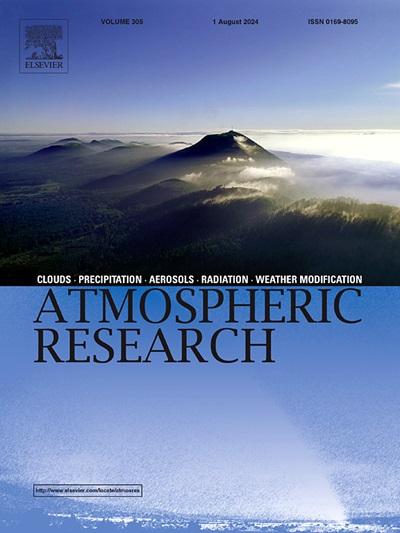The role of Madden-Julian Oscillation, Westerly Wind Bursts, and Kelvin Waves in triggering extreme rainfall through Mesoscale Convective Systems: A case study of West Sumatra, March 7–8, 2024
IF 4.5
2区 地球科学
Q1 METEOROLOGY & ATMOSPHERIC SCIENCES
引用次数: 0
Abstract
The West Sumatra region experienced devastating floods and landslides due to intense rainfall on March 7–8, 2024, with precipitation ranging from 200 to 394 mm/day exceeding the extreme rainfall threshold of 150 mm/day. We investigated the atmospheric dynamics to understand the mechanisms underlying this event. We used satellite data from Himawari-8 and Global Satellite Mapping of Precipitation (GSMaP) and ground-based observations to analyze cloud development and rainfall distribution. Wind velocity, Integrated Water Vapor Transport (IVT), Convective Available Potential Energy (CAPE), Convective Inhibition (CINH), K-Index, Vertically Integrated Moisture Flux Convergence (VIMFC), and Outgoing Longwave Radiation (OLR) from ERA5 reanalysis datasets are used to analyze convective instability and identify Equatorial waves. The Hybrid Single-Particle Lagrangian Integrated Trajectory (HYSPLIT) model was employed to assess moisture transport. Our findings indicate that extreme rainfall was driven by the Mesoscale Convective System (MCS), as confirmed by cloud observations from Himawari-8. Further analysis revealed that moisture convergence, intensified by a Westerly Wind Burst (WWB) from the Indian Ocean, interacted with local topography and atmospheric circulations over West Sumatra. This interaction was associated with an active Madden-Julian Oscillation (MJO) in Phase 4, strengthening the westerly winds, transporting moisture and fueling convection. Before the event, MJO activity in Phase 3 over the Indian Ocean coincided with an atmospheric Kelvin wave, intensifying low-level convergence, enriching the Indian Ocean region with moisture, and transporting it to West Sumatra via the WWB. The interplay of the MJO, WWB, and Kelvin waves likely amplified the event. This study provides insights into the atmospheric processes behind this event and highlights their importance in developing early warning systems for future events.

求助全文
约1分钟内获得全文
求助全文
来源期刊

Atmospheric Research
地学-气象与大气科学
CiteScore
9.40
自引率
10.90%
发文量
460
审稿时长
47 days
期刊介绍:
The journal publishes scientific papers (research papers, review articles, letters and notes) dealing with the part of the atmosphere where meteorological events occur. Attention is given to all processes extending from the earth surface to the tropopause, but special emphasis continues to be devoted to the physics of clouds, mesoscale meteorology and air pollution, i.e. atmospheric aerosols; microphysical processes; cloud dynamics and thermodynamics; numerical simulation, climatology, climate change and weather modification.
 求助内容:
求助内容: 应助结果提醒方式:
应助结果提醒方式:


